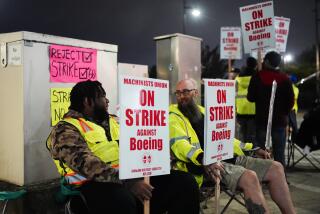Union Members, All 63 of Them, Gird Themselves for Sixth Winter on Strike
CLEVELAND — It’s an ugly sight. Blood-red words shouting “Locked out” fastened to high, rickety fences surrounding a dirty foundry.
Between shifts, a few frustrated members of United Auto Workers Local 91 keep a vigil near a shanty, preparing to dig in for their sixth winter on strike against the Ohio Crankshaft Division of Park Ohio Industries.
When the strike began July 11, 1983, 120 union members walked off their jobs in solidarity, vowing to hold out on $100 a week in strike pay until they secured a satisfactory labor agreement.
Five years later, that vow remains--as does the stipend--but retirements, job changes and deaths have reduced the solidarity ranks to 63.
“We never dreamed it would go this far,” said Local 91 president Gus Golias, 64, who began working at Ohio Crankshaft 47 years ago. “We’re managing. It’s not easy. We got our pickets out here. They come here faithfully every day.”
UAW Region 2 representative Richard Vadovski said: “These people have been on the picket line for 5 years. You can bet they’re strong.”
Vadovski said that despite the length of the strike and the company’s objective to “bust the union,” negotiations have continued over the years. The last meeting was held Nov. 9 and another session is planned in the “near future.”
“We still have the corporation at the bargaining table,” Vadovski said. “I have a feeling we’re going to get an agreement with them. Our people are going back to work.”
But Golias is not so optimistic. He described company lawyer Dianne Stanton of Atlanta as a “union buster” and said Ohio Crankshaft “is just trying to evade us in order to keep us out.”
Stanton refused to respond to the charges and directed all questions to company officials in Cleveland, who were not available for comment.
Ohio Crankshaft has hired replacement workers, but the National Labor Relations Board has ruled that the company engaged in unfair labor practices, which effectively guarantees the union workers will get their jobs back when the strike is settled.
John Russo, a professor of labor studies at Youngstown State University, said that because of the ruling, the company could be forced to give the striking workers back pay.
An NLRB attorney who asked not to be named said the charges of unfair labor practices stem from two sets of complicated cases.
In 1979, the labor board determined that Ohio Crankshaft acted unfairly when it moved part of a division from Cleveland to Boaz, Ala., after the company had agreed with the union that such moves were subject to bargaining.
That case, the NLRB lawyer said, involves some back pay for the workers, but the amount has not been determined. “Trying to determine how much money they lost is an accounting nightmare,” he said.
The other set of cases began in 1983 when the labor board determined that the company engaged in bad-faith bargaining by refusing to furnish the union with certain information. That incident led to the marathon strike.
Vadovski said the company also attempted to cut off retirement benefits from those who retired during the strike, triggering a lawsuit filed by the union. That case is pending in the U.S. 6th Circuit Court of Appeals in Cincinnati.
“They attempted to gut the entire labor agreement,” Vadovski said. “And under this anti-labor (Reagan) Administration, even the NLRB saw how dirty this corporation was.”






